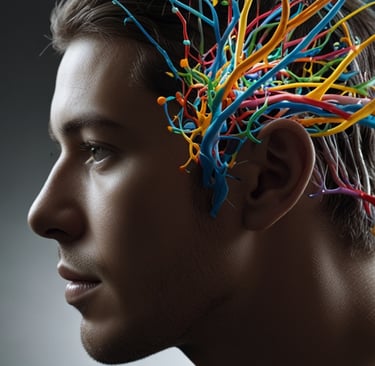🧠 Why You Think the Way You Do (And How to Change It)
Go beyond neuroplasticity and uncover how early emotional experiences shaped your thought patterns — and how to rewire them from the root.
Michelle Clark, BSN, RN, NC
6/22/202512 min read


Uncovering the Hidden Wiring Beneath Your Thoughts
Let’s start with a brutally honest truth:
You did not create most of your thoughts.
You most likely inherited them.
Before your first heartbreak.
Before your first job.
Before your first real mistake…
Your brain already had a blueprint from which to go by. A map that you use to view the world — and yourself.
This map is your blueprint, and it lives below your conscious mind, in your subconscious, taking control more often than you realize. You may have thought you were in control but if you do not have control over your subconscious, you are likely deluding yourself and not in control at all. It doesn’t have to be this way though, so ….
In this week’s post, we will be going into more detail about last week’s post “The Science of Rewiring Your Brain,” Where we’re going deeper than the basics of neuroplasticity. In fact, this will be a short course in “Neuroplasticity 101.”
We will uncover why your brain formed the thought patterns it did — and how to start rewriting your original script.


Step One: Understanding That Your Thoughts Aren’t Always Yours
Most of your beliefs — especially about yourself — were formed unconsciously. These beliefs were forming before you were even aware you were forming them.
During childhood, our brains are in a hyper-receiving state, especially between ages 0–7, making us like little super sponges during the early part of our lives. We absorbed everything that came our way, good or bad. The problem with this system is the subconscious doesn’t know the difference and does not differentiate right from wrong or good from bad, it only collects and stores the data for fast retrieval later should another experience reminiscent of the past occur.
Psychologists refer to this as a high-theta brainwave state — a learning state where your brain is imprinting or collecting all incoming information but not analyzing it. Meaning your brain is only collecting data, it has not gotten to the stage of processing that data. This lack of processing makes the subconscious believe everything incoming is the truth. As I stated, the subconscious doesn’t differentiate or know facts from fallacy, even the toxic, dysfunctional, and trauma-filled data will become embedded into your blueprint as truth, making you believe and function as if it were.
Your brain isn’t asking, “Is this true?”
It’s asking, “Is this what normal looks like?”
So, if you experienced, particularly in years 0-7:
Criticism instead of encouragement
Abuse instead of protection
Abandonment instead of security
Chaos instead of safety
Inconsistency instead of trust
Emotional distance instead of connection
Then it is likely that your brain developed an unhealthy tool kit to survive those conditions because your blueprint was wired to believe these are normal and appropriate responses to those triggers.
This is not because they were correct — but because they were repeated and emotionally charged, creating unhealthy pathways in the subconscious. Making these experiences part of what your brain will consider normal.
Unfortunately, the subconscious doesn’t care about accuracy.
It only cares about what feels real and comes frequently to the current wiring it was programmed into.


The Hidden Curriculum: How Your Environment Programs You
I’ve heard the phrase many times over that “you are not your circumstances”, but I strongly disagree with this statement. Everything we are exposed to, especially in early life, becomes our teachers for how we decide to maneuver and survive in this world.
Not only were your parents and family your first teachers but so were your circumstances and environment. What you were taught in school, learned in music & TV programs along with the actions, behaviors, words, and experiences of our parents and family helped shape your foundation during those first 7 years. All these things become your first teachers — whether they’re meant to or not.
This includes:
The tone of your household
The emotional availability of your caregivers
The language used when you made mistakes
How conflict, affection, and attention were handled
Even if no one said, “you’re not good enough,” your brain might’ve perceived that through actions and behaviors like body language:
Eye rolls
Being judged or ridiculed
Being dismissed or scolded all the time
Being ignored when you try to express yourself emotionally
Being praised only when you achieve
And when this emotional learning happens in early life, it becomes part of your mental operating system — running silently in the background for years, if not decades.
A child silenced in childhood becomes a silenced adult.


The Role of Emotional Memory
Here’s where it gets even more amazing and powerful (and sneaky):
Much of this early wiring lives in your implicit memory system — the part of your memory that stores emotional responses and somatic associations, not stories or words.
This is why:
You can know a thought is irrational, but still feel it
You can say “I’m safe” but still feel afraid
You can love someone and still sabotage the connection
You can say “I know my worth” but allow dishonor and disrespect
You can say “I’m healed” but still get triggered
These aren’t healthy, normal, or logical patterns.
They’re emotional imprints stored in your nervous system.
Until they’re updated, your brain will continue filtering life through them. This is your perception or view on life and determines how you make decisions for yourself.
Before we move forward, let’s dig a little deeper into what implicit memory is and how it plays a major role in the formation of your blueprint during your childhood.


🧠 What Is Implicit Memory?
And Why It’s the Key to Your Emotional Triggers
When we think of memory, most people think of explicit memory — facts, events, things you can recall on command.
But implicit memory is different because it is the emotional response to an experience.
It’s non-verbal, emotional, and feeling-based. It stores how experiences made you feel, not the actual action. It is not what happened in words, but how those actions made your body feel in response.
Think of it like this:
Explicit memory: “I remember my 7th birthday party. We had cake.”
Implicit memory: “I remember dropping my cake at my 7th birthday party. I was embarrassed when I was yelled at now, yelling is really triggering for me, I always feel ashamed.”
Implicit memory is the invisible archive that holds emotional reactions, physical sensations, reflexes, and learned patterns — and it’s active even if you are not or have any conscious memory of an event.
👶 Implicit Memory Is Formed in Childhood
From birth to about age 7, your brain is still developing the structures required for explicit memory (like the hippocampus and prefrontal cortex).
But your implicit memory system is already online, ready to record.
That means your body and nervous system are constantly recording information like:
What gets you love or attention
What causes disconnection or danger
What emotions are “safe” to express
Whether you are soothed or ignored when in distress
Even if you can’t remember being left to cry at night, being shamed for expressing anger, or being emotionally neglected — your nervous system remembers.
These experiences become emotional blueprints that guide:
How you regulate (or suppress) emotion
What to expect from relationships
How you respond to perceived rejection, failure, or chaos
What you feel you must do to stay connected or safe


🧠 Implicit Memory in Adulthood


You might be operating from implicit memory if you’ve ever said things like:
“I don’t know why I panic when someone raises their voice.”
“I always freeze when I try to speak up, even when I’m not in danger.”
“I logically know I’m safe, but my body still freaks out.”
“I keep choosing the same kind of toxic partner — it just feels familiar.”
“Seeing that interaction was very triggering and I don’t know why.”
That “just feels familiar” part is your implicit memory working.
It guides your:
Emotional reactions
Instinctive behaviors
Gut feelings
Triggers and freeze responses
Attachment styles
…. And it never asks your permission before stepping in and taking over, it just springs into action.


⚙️ Implicit Memory Is Emotional Conditioning
Just like you learned things that eventually became routine, happening on autopilot, like learning how to ride a bike or drive a car without thinking, you also learned emotional reflexes or patterns of unhealthy defense mechanisms built into your subconscious:
Crying = believed to be bad → teaches you to suppress sadness
Conflict = causes a feeling of being unsafe → teaches you to avoid hard conversations
Being loud = leads to fear of being punished → keeps you in a small mindset
Achievement = gives a rush feeling of being worthy of being loved → leads to overachieving for approval and to feel worthy
These patterns were not taught to you consciously and you didn’t learn them through formal education. How you learned them was through lived experience with your body storing these patterns in your subconscious, silently, ready for quick retrieval when triggered in the future.


🪄 A Big Takeaway: Implicit Memory Is Really Your Personality
A big takeaway is what you feel is likely how you were conditioned.
What feels like “that’s just how I am” is really, just the way I was conditioned. It was what you were taught to believe as your truth, becoming solidified through your emotional responses, which makes it stick and real to you.
Many beliefs, fears, and behaviors that seem like part of your identity are really your implicit responses to the emotional environments you did not choose.
This means:
You’re not “bad at relationships” — you just may have never learned healthy love = inconsistency in how love is displayed in your life and how you display love in return (toxic love)
You’re not “weak” — you just may have learned anger and having a voice are not safe for you making you shut down instead of stand in your power
You’re not “too sensitive” — you may have grown up where no one validated your feelings and emotions making you feel unheard, rejected, and abandoned
When you learn how to read the implicit memory behind your reactions, you will stop blaming yourself — and you will start understanding yourself.
💡 Can You Change Implicit Memory?
Absolutely — and this is where healing gets good.
While you can’t “erase or delete” implicit memory, you can retrain your nervous system and emotional responses through:
New emotional experiences (especially in safe environments)
Repetition of new thoughts + behaviors (you know what they say, practice makes perfect)
Body-based healing (somatic work, breath work, inner child work)
Mindful interruption + conscious reprocessing (practicing mindfulness to keep you in the present moment allows you to process your processing giving time and space to change it when necessary)
This is exactly why things like:
Re-parenting exercises
Somatic therapy (which draws a connection between the mind and body by tuning into those physical sensations to access and release stored emotional experiences)
EMDR (Eye Movement Desensitization & Reprocessing – this targets the traumatic memory and allows it to be reprocessed & new sensations to be integrated as new emotional memory replacements)
Inner child journaling (this allows you to go back and address any trauma that occurred in childhood by writing those feelings out from the view of your inner child and addressing them today as if they were addressed in your childhood, this will provide you the opportunity to treat yourself as you needed to be treated and cared for back then)
Cultivating safe, secure relationships
…are powerful.
They don’t just teach you something new — they offer your body a new emotional truth to rewire in your subconscious and nervous system because remember, emotional responses are from the nervous system and stored in the subconscious.


🔁 Example: Rewiring Through New Experience
Let’s say you learned when you:
“Express emotion = you will be ignored”
As a result, every time you feel overwhelmed, you shut down. That is your implicit memory in action.
Now imagine someone sitting with you in your emotions, validating you and offering you a safe space to feel seen and heard, not abandoned like you felt in the past.
If this level of support happens repeatedly, offering you safety with consistency, your body starts to learn:
“Maybe expressing myself doesn’t always mean danger.”
That’s neuroplasticity meeting implicit memory.
This is the start of a new pattern being created.
🤔 “You May Be Thinking — But I’m Self-Aware — Why Am I Still Stuck?”
This is one of the most frustrating parts of healing:
You know your inner critic is lying.
You know you're not that scared child anymore.
You know you've come a long way...
…but it still feels real.
Why?
Because awareness lives in the prefrontal cortex — your logical, conscious brain.
But emotional patterns live in the limbic system and brainstem — which operate automatically and reactively.
So, unless you bring your emotional learning into alignment with your cognitive awareness, your body will keep “thinking” you’re still in the past.


🧑🏽💻 How to Discover Your Original Programming 👩🏽💻
Let’s try an exercise.
Here are a few questions to help you uncover the original scripts that shaped your thoughts:
🔍 Who did I have to be to feel safe, seen, or loved growing up?
The achiever? The caretaker? The quiet one?
🧱 What emotions were allowed in my home — and which ones weren’t?
Was sadness met with comfort or shame?
Was anger punished or ignored?
🪞When I made mistakes, how were they handled?
Were you taught to accept your mistakes, learn and move on from it? Or were you taught to suppress and hide?
🧠 What were you shown about love, money, worth, and failure?
You don’t need to blame your past.
But you do need to recognize it and see it clearly — because what isn’t recognized is repeated and what isn’t seen stays stuck.


💪🏽 Real Work of Rewiring Starts Here
🧭 What You Can Do Right Now
✅ Step 1: Name the Pattern & Watch Your Emotional Responses
Every pattern started as a way to cope and adapt to your surroundings.
Once you recognize that your thoughts are responses to an old, emotional “playbook,” you can stop trying to fight them — and start rewiring your subconscious.
Here’s how that looks:
Instead of “I’m a mess,” you say:
“This is an old protection script showing up.”
Take time to notice the moments when you overreact in situations where your reaction outweighs your reality - that’s usually a sign.
Take a moment to pause and ask:
“What does this feeling remind me of?”
“What does my body think is happening right now?”
“Is this now, or was this then?”
✅ Step 2: Validate Your Original Needs Instead of Shaming Yourself for Them
Instead of trying to force something to make sense, try accepting the thought instead by saying:
“Of course, I feel this way - this is what I learned to expect as normal.”
“I became hyper-independent because I needed to feel safe.”
“I people-please to feel accepted.”
This takes shame off the table — and makes space for change.
This simple act of giving yourself grace shifts you out of self-blame and a victim mindset, and pushes you into self-connection, and away from being a victim in your own life.
✅ Step 3: Introduce New Emotional Wiring by Meeting Your Needs Differently
You can’t change or fix the past, but you can give your system new options to choose from:
Practice healthy bonding
Express without judgment or guilt
Journal as your inner child who had to find protection through shutting down
Use mindful movement (Yoga, Tai Chi, Qigong, or simple dancing), voice work (usually used by singers but great at bringing balance and alignment to the entire body), or breath work (diaphragmatic breathing to release what got stuck)
Ask yourself:
· “What is this belief trying to protect me from — and how can I meet that need differently now?”
That’s real rewiring.
Not just thinking differently — but feeling safe enough to think differently.
Every time you show your system something new, you teach it that there are other possibilities and the world — and you — are safer than they once were.


💭 Final Thought: You’re Not Just Breaking Old Patterns — You’re Updating Your Whole Operating System
This goes beyond “positive thinking.”
It’s about becoming the conscious author of your reality which starts in your inner world — instead of living by a script you didn’t write. It is time to collect your pens from anyone you’ve given your power away to, to write your story for you.
Your thoughts make sense when you understand what trained them.
Your reactions soften when you see where they started – you will learn to give yourself grace and empathy.
And your healing accelerates when you give yourself - new information.
Your brain is flexible. The blueprint can still be rewritten.
You’re not too late. You’re just getting comfortable taking back possession of all your pens.
Your world becomes clearer when you learn your true authentic self without the need for masks, the desire to people please, or with the belief that your needs will be met outside of you. You have everything you need inside of you ready for you to recognize and activate your innate power.
Know thyself is not just a Bible verse, it should become your life’s mission because this will be the most important relationship you will ever have and that is being in relationship with YOU!
💡 Ready to Reprogram Thought by Thought?
Join my email list and download your free Break the Loop Guide — complete with:
A subconscious belief audit
7 steps to interrupt old wiring
Rewire your Brain Downloadable PDF
Downloadable 7-Day Habit Tracker
Empowerment
Transform your health through holistic nurse coaching.
For Support
believe in the POSSIBILITIES! believe in yourself!
Connect Now
(612) 367-7863
© 2025. All rights reserved.
BOOK YOUR SESSION WITH NC CHELLE, RN NOW! CLICK BELOW!!!
Email: michelle.clark@blossomingsoulsllc.com
blossomingsoulsllc1@yahoo.com
